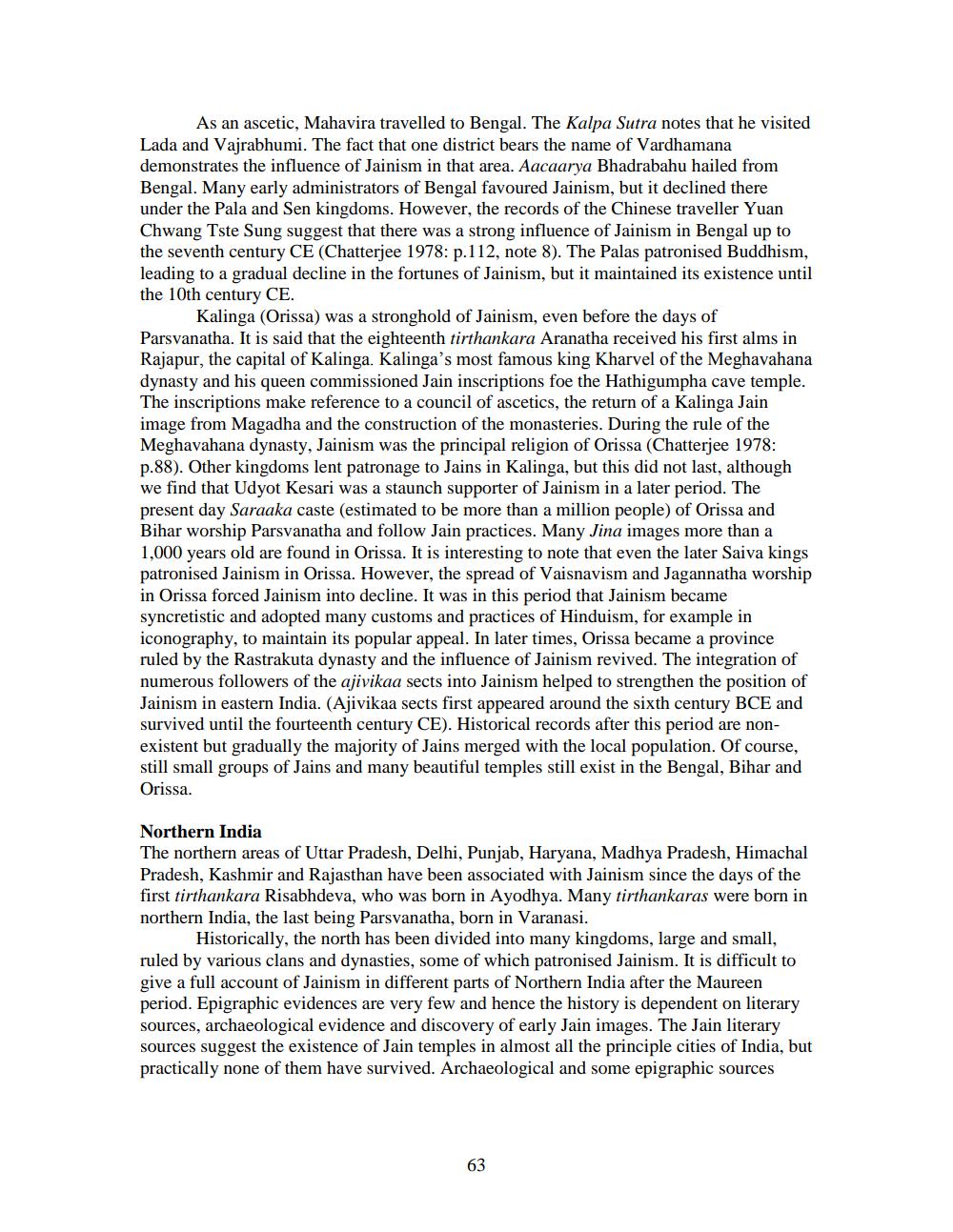________________
As an ascetic, Mahavira travelled to Bengal. The Kalpa Sutra notes that he visited Lada and Vajrabhumi. The fact that one district bears the name of Vardhamana demonstrates the influence of Jainism in that area. Aacaarya Bhadrabahu hailed from Bengal. Many early administrators of Bengal favoured Jainism, but it declined there under the Pala and Sen kingdoms. However, the records of the Chinese traveller Yuan Chwang Tste Sung suggest that there was a strong influence of Jainism in Bengal up to the seventh century CE (Chatterjee 1978: p.112, note 8). The Palas patronised Buddhism, leading to a gradual decline in the fortunes of Jainism, but it maintained its existence until the 10th century CE.
Kalinga (Orissa) was a stronghold of Jainism, even before the days of Parsvanatha. It is said that the eighteenth tirthankara Aranatha received his first alms in Rajapur, the capital of Kalinga. Kalinga's most famous king Kharvel of the Meghavahana dynasty and his queen commissioned Jain inscriptions foe the Hathigumpha cave temple. The inscriptions make reference to a council of ascetics, the return of a Kalinga Jain image from Magadha and the construction of the monasteries. During the rule of the Meghavahana dynasty, Jainism was the principal religion of Orissa (Chatterjee 1978: p.88). Other kingdoms lent patronage to Jains in Kalinga, but this did not last, although we find that Udyot Kesari was a staunch supporter of Jainism in a later period. The present day Saraaka caste (estimated to be more than a million people) of Orissa and Bihar worship Parsvanatha and follow Jain practices. Many Jina images more than a 1,000 years old are found in Orissa. It is interesting to note that even the later Saiva kings patronised Jainism in Orissa. However, the spread of Vaisnavism and Jagannatha worship in Orissa forced Jainism into decline. It was in this period that Jainism became syncretistic and adopted many customs and practices of Hinduism, for example in iconography, to maintain its popular appeal. In later times, Orissa became a province ruled by the Rastrakuta dynasty and the influence of Jainism revived. The integration of numerous followers of the ajivikaa sects into Jainism helped to strengthen the position of Jainism in eastern India. (Ajivikaa sects first appeared around the sixth century BCE and survived until the fourteenth century CE). Historical records after this period are nonexistent but gradually the majority of Jains merged with the local population. Of course, still small groups of Jains and many beautiful temples still exist in the Bengal, Bihar and Orissa.
Northern India
The northern areas of Uttar Pradesh, Delhi, Punjab, Haryana, Madhya Pradesh, Himachal Pradesh, Kashmir and Rajasthan have been associated with Jainism since the days of the first tirthankara Risabhdeva, who was born in Ayodhya. Many tirthankaras were born in northern India, the last being Parsvanatha, born in Varanasi.
Historically, the north has been divided into many kingdoms, large and small, ruled by various clans and dynasties, some of which patronised Jainism. It is difficult to give a full account of Jainism in different parts of Northern India after the Maureen period. Epigraphic evidences are very few and hence the history is dependent on literary sources, archaeological evidence and discovery of early Jain images. The Jain literary sources suggest the existence of Jain temples in almost all the principle cities of India, but practically none of them have survived. Archaeological and some epigraphic sources
63




